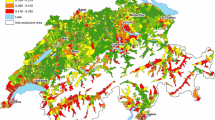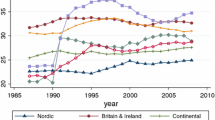Abstract
The relationship between income inequality and mortality has come into question as of late from many within-country studies. This article examines the relationship between income inequality and working-age mortality for metropolitan areas (MAs) in Australia, Canada, Great Britain, Sweden, and the United States to provide a fuller understanding of national contexts that produce associations between inequality and mortality. An ecological cross-sectional analysis of income inequality (as measured by median share of income) and working-age (25–64) mortality by using census and vital statistics data for 528 MAs (population >50,000) from five countries in 1990–1991 was used. When data from all countries were pooled, there was a significant relationship between income inequality and mortality in the 528 MAs studied. A hypothetical increase in the share of income to the poorest half of households of 1% was associated with a decline in working-age mortality of over 21 deaths per 100,000. Within each country, however, a significant relationship between inequality and mortality was evident only for MAs in the United States and Great Britain. These two countries had the highest average levels of income inequality and the largest populations of the five countries studied. Although a strong ecological association was found between income inequality and mortality across the 528 MAs, an association between income inequality and mortality was evident only in within-country analyses for the two most unequal countries: the United States and Great Britain. The absence of an effect of metropolitan-scale income inequality on mortality in the more egalitarian countries of Canada. Australia, and Sweden is suggestive of national-scale policies in these countries that buffer hypothetical effects of income inequality as a determinant of population health in industrialized economies.
Similar content being viewed by others
References
Deaton A, Lubotsky D. Mortality, inequality and race in American cities and states. Soc Sci Med. 2003;56:1139–1153.
Mackenbach JP. Income inequality and population health: evidence favouring a negative correlation between income inequality and life expectancy has disappeared. BMJ. 2002;324:1–2.
Wagstaff A, van Doorslaer E. Income inequality and health: what does the literature tell us? Annu Rev Public Health. 2002;21:543–567.
Rodgers GB. Income and inequality as determinants of mortality: an international crosssection analysis. Popul Stud. 1979;33:343–351. Reprinted in: Int J Epidemiol. 2002;31:549–551.
Wilkinson RG. Income distribution and life expectancy. BMJ. 1992;304:165–168.
Lynch JW, Smith GD, Hillemeier M, Shaw M, Raghunathan T, Kaplan GA. Income inequality, the psychosocial environment, and health: comparisons of wealthy nations. Lancet. 2001;358:194–200.
Kaplan GA, Pamuk ER, Lynch JW, Cohen RD, Balfour JL. Inequality in income and mortality in the United States: analysis of mortality and potential pathways. BMJ. 1996;312:999–1003.
Kennedy BP, Kawachi I, Prothrow-Stith D. Income distribution and mortality: crosssectional ecological study of the Robin Hood index in the United States. BMJ. 1996;312:1004–1007.
Lochner K, Pamuk E, Makuc D, Kennedy BP, Kawachi I. State-level income inequality and individual mortality risk: a prospective, multi-level study. Am J Public Health. 2001;91:385–391.
Subramanian SV, Kawachi I, Kennedy BP. Does the state you in live in made a difference? Multilevel analysis of self-rated health in the U.S. Soc Sci Med. 2001;53:9–19.
Blakely TA, Lochner K, Kawachi I. Metropolitan area income inequality and self-rated health-a multi-level study. Soc Sci Med. 2002;54:65–77.
Lynch JW, Kaplan GA, Pamuk ER, et al. Income inequality and mortality in metropolitan areas of the United States. Am J Public Health. 1998;88:1074–1085.
Mellor JM, Milyo J. Reexamining the evidence of an ecological association between income inequality and health. J Health Polit Policy Law. 2001;487–522.
Mellor JM, Milyo J. Is exposure to income inequality a public health concern? Lagged effects of income inequality on individual and population health. Health Serv Res. 2003;1(pt 1):137–151.
Ross NA, Wolfson MC, Dunn JR, Berthelot JM, Kaplan GA, Lynch JW. Relation between income inequality and mortality in Canada and in the United States: cross sectional assessment using census data and vital statistics. BMJ. 2000;320:898–902.
Shibuya K, Hashimoto H, Yano E. Individual income, income distribution, and self rated health in Japan; cross sectional analysis of nationally representative sample. BMJ. 2002;324:16.
Osler M, Prescott E, GrØnbæk M, Christensen U, Due P, Engholm G. Income inequality, individual income, and mortality in Danish adults: analysis of pooled data from two cohort studies. BMJ. 2002;324:13.
Blakely T, Atkinson J, O’Dea D. No association of income inequality with adult mortality within New Zealand: a multi-level study of 1.4 million 25–64 year olds. J Epidemiol Community Health. 2003;57:279–284.
Weich S, Lewis G, Jenkins SP. Income inequality and self-rated health in Britain. J Epidemiol Community Health. 2002;56:436–441.
Wilkinson RG. Mind the Gap: Hierarchy, Health and Human Evolution. London: Weidenfeld & Nicolson; 2001 and New Haven, CT: Yale University Press; 2001. Darwinism Today Series.
Wilkinson RG. Unhealthy Societies: The Afflictions of Inequality. London: Routledge; 1996.
Ross NA, Nobrega K, Dunn JR. Economic segregation and mortality in North American netropolitan areas, Geojournal. 2002;53(special issue):2001.
Guest AM, Almgren G, Hussey JM. The ecology of race and socioeconomic distress: infant and working-age mortality in Chicago. Demography. 1998;35:23–34.
Gravelle H. How much of the relationship between population mortality and unequal distributions of income is a statistical artefact? BMJ. 1998;314:382–385.
Wolfson MC, Kaplan G, Lynch J, Ross NA, Backlund J. The relationship between income inequality and mortality is not a statistical artefact — an empirical assessment BMJ. 1999;319:953–957.
Sanmartin C, Ross NA, Tremblay S, Wolfson MC, Dunn JR, Lynch JL. Labour market income inequality and mortality is North American metropolitan areas. J Epidemiol Community Health. Forthcoming.
Coombes MG, Dixon JS, Goddard JB, Openshaw S, Taylor PJ. Daily urban systems in Britain: from theory to practice. Environ Plann. 1979;11:565–574.
Insightful Corporation. S-PLUS 6 for Windows, Guide to Statistics. Vol 1. Seattle, WA: Insightful Corporation; 2001.
Chatterjee S, Price B, Regression Analysis by Example. New York, NY: John Wiley and Sons Inc; 1991.
Lynch JW, Davey Smith G. Commentary: income inequality and health: the end of the story? Int J Epidemiol. 2002;31:549–551.
Wilkinson RG. Two pathways, but how much do they differ? BMJ. 1999;319:956–957.
Lynch JW, Kaplan GA. Understanding how inequality in the distribution of income affects health. J Health Psychol. 1997;2:297–314.
Badcock B. Unfairly Structured Cities, Oxford: Blackwell; 1984.
Harvey D. Social Justice and the City. Oxford: Blackwell; 1973.
Organisation for Economic Co-operation and Development (OECD). CD-ROM on Social Expenditure database, 2001. Available at: http://www.oecd.org/els/social/indicators. Accessed XXXX 00, 0000.
Lynch JW. Income inequality and health: expanding the debate. Soc Sci Med. 2001;51:1000–1005.
Lynch JW, Davey Smith G, Kaplan GA, House J. Income inequality and mortality: importance to health of individual income, psychosocial environment, or material conditions. BMJ. 2000;320:1200–1204.
Davey Smith G. Income inequality and mortality: why are they related? Income inequality goes hand in hand with underinvestiment in human resources. BMJ. 1996;312:987–988.
Author information
Authors and Affiliations
Corresponding author
Rights and permissions
About this article
Cite this article
Ross, N.A., Dorling, D., Dunn, J.R. et al. Metropolitan income inequality and working-age mortality: A cross-sectional analysis using comparable data from five countries. J Urban Health 82, 101–110 (2005). https://doi.org/10.1093/jurban/jti012
Accepted:
Issue Date:
DOI: https://doi.org/10.1093/jurban/jti012




